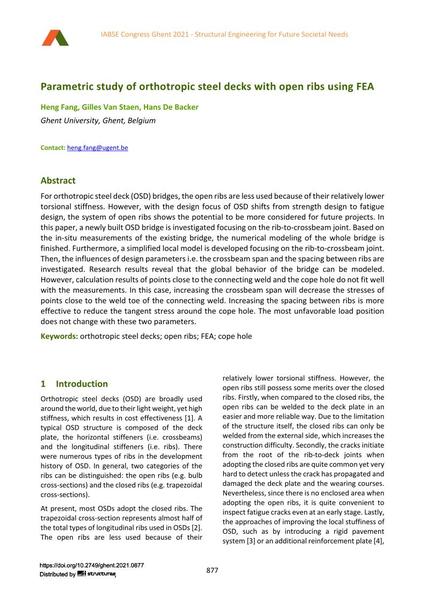Parametric study of orthotropic steel decks with open ribs using FEA

|
|
|||||||||||
Bibliographic Details
| Author(s): |
Heng Fang
Gilles Van Staen Hans De Backer |
||||
|---|---|---|---|---|---|
| Medium: | conference paper | ||||
| Language(s): | English | ||||
| Conference: | IABSE Congress: Structural Engineering for Future Societal Needs, Ghent, Belgium, 22-24 September 2021 | ||||
| Published in: | IABSE Congress Ghent 2021 | ||||
|
|||||
| Page(s): | 877-884 | ||||
| Total no. of pages: | 8 | ||||
| DOI: | 10.2749/ghent.2021.0877 | ||||
| Abstract: |
For orthotropic steel deck (OSD) bridges, the open ribs are less used because of their relatively lower torsional stiffness. However, with the design focus of OSD shifts from strength design to fatigue design, the system of open ribs shows the potential to be more considered for future projects. In this paper, a newly built OSD bridge is investigated focusing on the rib-to-crossbeam joint. Based on the in-situ measurements of the existing bridge, the numerical modeling of the whole bridge is finished. Furthermore, a simplified local model is developed focusing on the rib-to-crossbeam joint. Then, the influences of design parameters i.e. the crossbeam span and the spacing between ribs are investigated. Research results reveal that the global behavior of the bridge can be modeled. However, calculation results of points close to the connecting weld and the cope hole do not fit well with the measurements. In this case, increasing the crossbeam span will decrease the stresses of points close to the weld toe of the connecting weld. Increasing the spacing between ribs is more effective to reduce the tangent stress around the cope hole. The most unfavorable load position does not change with these two parameters. |
||||
| Keywords: |
orthotropic steel decks FEA open ribs cope hole
|
||||
| Copyright: | © 2021 International Association for Bridge and Structural Engineering (IABSE) | ||||
| License: | This creative work is copyrighted material and may not be used without explicit approval by the author and/or copyright owner. |
||||
